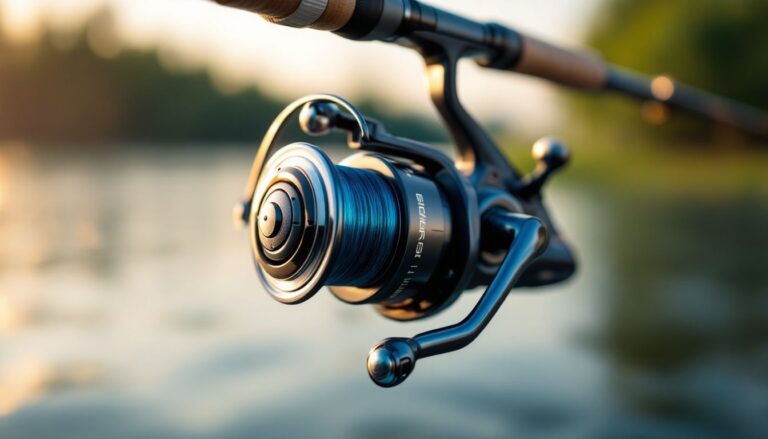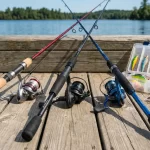Bass fishing enthusiasts constantly seek ways to improve their angling skills and increase their chances of reeling in the biggest catch. Locating where these elusive creatures hide in the vast and unpredictable waters can be quite challenging. That’s where a fish finder comes into play, transforming your fishing experience entirely.
This article delves into practical and effective techniques for efficiently using a fish finder for bass fishing. With its reliable sonar technology and intuitive interface, a fish finder can be an invaluable tool to help you navigate the depths, identify underwater structures, and pinpoint the exact locations of those prized bass.
With the insights shared here, you’ll be equipped with the necessary knowledge to master the art of using a fish finder, ultimately improving your chances of success on every fishing trip.
Table of contents
Quick Tips
- Ensure the fish finder is properly installed on your bass boat, securely mounted, and positioned for optimal performance.
- Familiarize yourself with the controls and settings of your fish finder, such as sensitivity, zoom, and frequency, to better understand the underwater environment.
- Start by using the fish finder’s sonar to locate underwater structures like weed lines, drop-offs, and submerged rocks, which are popular hiding spots for bass.
- Adjust the sensitivity of the fish finder to distinguish between the bottom and fish arches, ensuring you can accurately identify the size and depth of bass.
- Utilize the fish finder’s GPS or chartplotter features to mark productive spots, allowing you to return to those locations later, increasing your chances of consistently finding bass.
Choose the right fish finder: Look for a fish finder specifically designed for bass fishing, with features like high frequency, CHIRP technology, and side imaging to locate bass accurately.
An important device for every bass angler to consider is a fish finder. If you want the best results from your bass fishing, you need the right tools. With so many options available on the market, it can be overwhelming to choose the right one. However, following simple tips and tricks, you can narrow your choices and find the perfect fish finder for your bass fishing adventures.
The first step is to look for a fish finder specifically designed for bass fishing. Different types of fish require different techniques to catch them, and bass are no exception. Bass tends to hide beneath vegetation and structures, so it’s crucial to have a fish finder to locate them accurately. Look for features such as high frequency, which allows for better target separation, and CHIRP technology, which provides clearer more detailed images of the underwater environment.
In addition to high frequency and CHIRP technology, side imaging is another crucial feature to consider. This innovative technology allows you to scan the area on the sides of your boat, providing a wider view of the underwater landscape. This can be incredibly useful when targeting bass, as it allows you to identify potential hiding spots and structures that are not directly below your boat. By having a fish finder with side imaging capabilities, you’ll have a significant advantage in locating bass and increasing your chances of a successful catch.
Once you have found a fish finder that meets these criteria, it’s also essential to consider other factors, such as ease of use and durability. Look for a fish finder with a user-friendly interface and intuitive controls, saving you time and frustration on the water.
Additionally, ensure that the unit is built to withstand the rigors of bass fishing, such as vibrations and exposure to water. By choosing a durable fish finder, you can be confident it will last for years and continue enhancing your bass fishing experience.
Finally, choosing the right fish finder can significantly improve the chances of your bass fishing trip being a success. Look for a device specifically designed for bass fishing, with features like high frequency, CHIRP technology, and side imaging.
These innovative technologies will allow you to accurately locate bass and identify potential hiding spots. Consider factors such as ease of use and durability to ensure a seamless and long-lasting fishing experience. So get out there, equip yourself with the right fish finder, and let the bass fishing adventures begin!
Understand the display: Familiarize yourself with the information on the fish finder’s screen, such as depth, temperature, fish icons, and structure. This will help you interpret the data and identify the potential bass location.
Understanding the display is crucial for effectively utilizing your fish finder. Take some time to familiarize yourself with the information shown on the screen. Pay attention to the data points, such as depth, temperature, fish icons, and structure. These indicators hold valuable insights that can greatly assist you in locating potential bass hotspots. By interpreting and understanding this data, you will be able to identify where the bass are likely to be hiding and increase your chances of having a successful fishing trip.
Now that you understand the display let’s dive into some step-by-step tips and tricks to enhance your fish-finding skills further.
Firstly, pay close attention to the depth reading. Bass tends to prefer certain depth ranges, and by understanding the depth display, you can target areas where bass are more likely to be found. Secondly, keep an eye on the temperature reading. Bass are temperature-sensitive creatures; knowing their preferred temperature range will give you a significant advantage.
By combining the depth and temperature data, you can narrow your search area and place your bait where the bass are more likely to bite.
Another important aspect that shouldn’t be overlooked is the fish icons displayed on your fish finder. These icons represent underwater targets, and with some practice, you’ll soon be able to differentiate between different fish species, including bass.
By distinguishing between these icons and understanding their behavior, you can effectively target the bass and avoid wasting time on less desirable species.
Lastly, take note of the structure information provided by your fish finder. Bass is notorious for seeking cover near submerged structures such as rocks, trees, or underwater vegetation. By paying attention to this data, you can identify areas with potential hiding spots for bass, increasing your chances of a successful catch.
If you want to locate bass effectively, you must understand your fish finder’s display. By familiarizing yourself with the various information on the screen, such as depth, temperature, fish icons, and structure, you can interpret the data and identify potential bass locations. Remember to follow the step-by-step tips and tricks, such as targeting specific depth and temperature ranges, interpreting fish icons, and locating underwater structures.
Applying these techniques enhance your fishing experience, increases your chances of landing the prized bass, and creates unforgettable memories on the water. Happy fishing!
Locate prime fishing spots: Use the fish finder to identify underwater structures like submerged rocks, brush piles, or drop-offs where bass gather. Pay attention to areas with significant changes in depth and temperature for higher chances of finding bass.
If you’re an avid angler looking to up your bass fishing game, one technique you should have in your arsenal is locating the prime fishing spots. While it may initially seem daunting, using a fish finder can greatly simplify the process.
These nifty devices can help you identify underwater structures that serve as hiding spots for bass, such as submerged rocks, brush piles, and drop-offs. It’s all about finding the spots where bass tends to gather and increasing your chances of a successful fishing trip.
Now that you have your trusty fish finder handy, let’s break down the steps to locate prime fishing spots effectively.
First and foremost, start by familiarizing yourself with the different readings displayed on your fish finder. Understanding the information it provides, such as depth, temperature, and fish arches, will be crucial in your quest to find bass hotspots.
Take some time to experiment with your device in different locations and conditions to understand better how it works.
Once you’ve got a handle on your fish finder, focus on areas that exhibit significant changes in depth and temperature. Bass are more likely to congregate in these spots as they provide optimal conditions for their feeding and breeding habits.
Look for sharp drop-offs, submerged structures, or sudden changes in water temperature, as these are known to attract bass. By honing in on these prime locations, you’ll significantly increase your chances of reeling in a trophy bass.
Remember that while a fish finder is invaluable, it’s not the only factor to consider when locating prime fishing spots. Consider other factors such as the time of day, weather conditions, and local knowledge. The combination of these elements will ensure a successful bass fishing outing.
So, next time you hit the water, grab your fish finder, pay attention to those depth and temperature changes, and get ready to reel in some impressive bass. Good luck, and happy fishing!
Conclusion
Following these steps, you can greatly improve your bass fishing game by using a fish finder. It is essential to have the right fish finder specifically designed for bass fishing, with features like high frequency, CHIRP technology, and side imaging. Familiarizing yourself with the display and understanding the information, such as depth, temperature, fish icons, and structure, allows you to interpret the data correctly and identify potential bass locations.
The ability to accurately locate underwater structures like submerged rocks, brush piles, or drop-offs can significantly increase your chances of finding bass. Incorporating a fish finder into your bass fishing strategy will save you time and effort and greatly enhance your fishing experience. So, don’t wait any longer – equip yourself with a fish finder and prepare to take your bass fishing skills to the next level.
You may also like 📖
-
10 Best Spinning Reel for Trout in 2023 (Buying Guide Review)
-
10 Best Saltwater Spinning Reels Under $100 – Ultimate Guide
-
10 Best River Trout Fishing Rods For 2023 Season: Expert Buying Guide
-
Can Baitcasters Improve Casting Accuracy More Than Spinning Rods?
-
What Length Spinning Rods Do You Need: (Finding the Perfect Fit)
-
How to Spool a Spinning Reel Like a Pro – Conquer Line Twist and Cast Like a Champion








